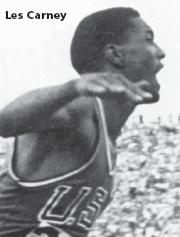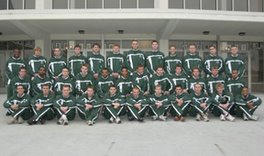Feminist-enforced Title IX harms male, female athletes
It’s been more than two months since the Ohio University Athletics Department unceremoniously dumped four sports teams from its program, and the outrage among student athletes and supporters has not subsided. Unfortunate¬ly, they’re not alone. OU is one of many schools that has eliminated sports teams in compliance with Title IX, the federal statute feminists use to dictate their vision of “gender equality” in college athletics.
On Jan. 24, Director of Athletics Kirby Hocutt announced the elimination of men’s indoor and outdoor track, men’s swimming and diving and women’s lacrosse. In addition to budget constraints, Hocutt cited Title IX as the reason for the cuts, describing them as the first steps in “the development of a comprehensive gender equity plan.”
Title IX, first implemented in 1972, forbids sex discrimination in schools that receive public funds. The original statute said nothing about sports, let alone quotas or strict gender proportionality in athletic programs. But feminist busybodies in the Carter administration invented the “proportionality test,” which dictates that the proportion of men and women in college athletics must be roughly equal to that of the student population.
Proportionality is one of three ways that schools can demonstrate compliance with Title IX. Schools can also comply by proving they have “continually expand¬ed” athletic opportunities for women or that female athletes’ interests have been “adequately accommodated,” according to the NCAA’s Web site. However, since the other two conditions are highly subjective, proportionality is the only option guaranteed to prevent Title IX lawsuits.
Unfortunately, gender proportionality in sports is in direct conflict with human reality. Every reasonable person realizes that men are generally more interested in athletics than women — a fact that remains easily measurable despite decades of feminist bullying.
For example, a Brown University study of incoming college freshmen found that 50 percent of men expressed interest in joining a sports team, but only 30 percent of women did. According to the Media Research Institute’s Web site, 75 to 80 percent of ESPN viewers are men. And, according to the NCAA, the vast majority of “walk-on” college athletes are men. Walk-ons are non-scholar¬ship students who try out for a team after recruitment has concluded. The fact that many more men than women are willing to sit on the bench for years, with little chance of starting in a game, says some¬thing about men’s relative interest in sports. Women athletes might be just as dedicated to their sport as men, but they are fewer in number.
This gender disparity seems to bother no one except the ruthless busybodies responsible for enforcing Title IX. Count¬less teams have been eliminated to create the illusion that women are just as eager as men to play sports. A recent report by the College Sports Council found that 2,200 men’s teams have been eliminated since 1981.
In addition to cutting men’s teams, many universities create women’s teams for sports that are easy to learn (such as crew) and offer athletic scholarships to students with no experience, according to a 2005 Eagle Forum report. As hundreds of male athletes lose their scholar¬ships after years of hard work, women get full rides for sports they’ve never played. This is the feminists’ idea of “fairness.”
Of course, some feminists have other motives for supporting a law that forces elimination of male teams. The Feminist Majority Foundation had this to say about men’s sports on its Web site: “By encouraging boys to become aggressive, violent athletes, and by encouraging girls to cheer for them, we perpetuate the cycle of male aggression and violence against women.”
Ironically, the bureaucrats dictating “gender equity” in college sports have also inadvertently hurt female athletes. Since Title IX reduces athletics to a numbers game, departments often cut teams indiscriminately until they achieve pro¬portion — and some of the axed athletes are women.
It’s time for students to pressure Congress to ban the proportionality test from Title IX enforcement. College athletic departments should be able to address the unique needs of student athletes as they see fit, without being forced to fill arbitrary quotas. The gender-equity police may be displeased with human nature, but that doesn’t give them the right to destroy teams that men — and women — love.
Ashley Herzog is a junior journalism major. Send her an e-mail at ah103304@ohiou.edu.
Monday, April 2, 2007
Subscribe to:
Post Comments (Atom)




















3 comments:
You need to more research, because your arguments are based on incorrect assumptions.
1) Congress did not put the proportionality test into place. It is an executive branch regulation derived from an act of legislative branch, as the executive branch does with every law passed by Congress. Congress does have the ability to change this regulation, but an attempt to do just that by the Dept. of Education several years ago met with failure.
2) Cutting sports is not a widespread phenomenon, but restricted to certain types of institutions. Specifically, schools that play Division 1-A football but outside the major conferences, or those making a big-time football upgrade. In other words, schools that spend a lot on football but are incapable of recouping their investment. Neither schools in the big-time conferences nor Division I-AA, II and III schools are cutting anything.
3) The cuts in men's sports programs over the last few years have nothing to do with Title IX. In fact, articles like yours prove its effectiveness as a smokescreen. Ohio University is no different from any of the others; sports died in order to get more money for football. My alma mater spent $2.2 million on a football stadium upgrade in the summer before cutting track and begging poverty, and it took us a while before we knew the AD was lying. OU figured it out much more quickly.
That AD, Paul Krebs, is now at New Mexico. This article:
http://media.www.dailylobo.com/media/storage/paper344/news/2007/04/02/Opinion/Track.Program.Left.In.Dust.Alford.Gets.Big.Paycheck-2817712.shtml
is very interesting in light of that fact. The basketball coach got a huge raise and track is getting the shaft. I predict their program will be gone within two years.
It is true that the propotionality rule is based on some faulty assumptions, such as that all sports have well-defined roster limits as basketball and baseball do. While Title IX clearly states that federal funds may not be used in a gender-biased way, it strange that none of the regulations even mention funding. Facilities used only by men can be palaces while those used only by women can be terrible, and that's OK. A university can offer a grossly disproportionate amount of scholarships, say 100 for men to 1 for women, and still be within the law. And so on.
Don't get me wrong--I share your pain. My alma mater were the ones who started cutting sports in the MAC. But you're barking up the wrong tree, and Hocutt likes it that way.
Yep, those are good points, you should email that comment to the author of the article, I believe it was Ashley Herzog at OU, ah103304@ohio.edu. Heck, OU will print that has a letter to the editor.
Ashley - as a top triathlete competing in Md, I have to agree with your observations - but let me expand them.
Did you know that in all of central Md there is no sprint triathlon open to men - yet we hold one for women only at Columbia (Iron girl).
The idea was that these folks might later join the mainstream of co-ed competition, but in fact - they just wait for the next Iron Girl the following year.
The troubling part of this is that although they get 1800 entrants - a co-ed race would get 3500. And, worst yet - EVERY co-ed triathlon already HAS a separate women’s race.
this lock iron Girl has on the region only offers the exclusion of men. And worst yet - no other promoter will confront the powerful race promoter of iron Girl by creating a competing co-ed race.
Post a Comment